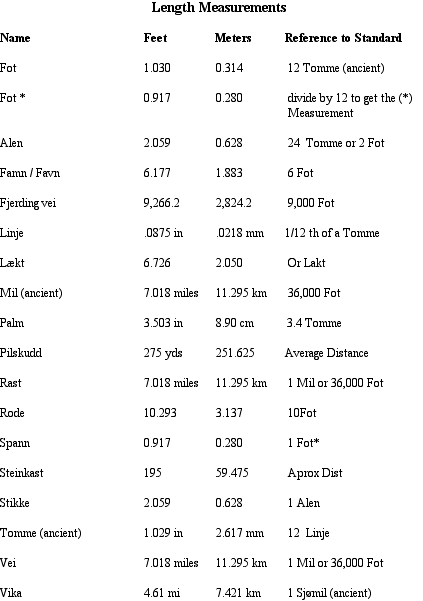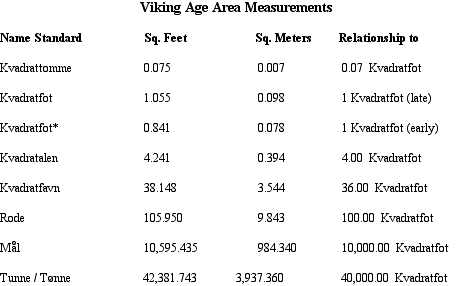Viking Measuring Systems
For those of us that make our own equipment, as well as those that do lectures, we've had a problem, what was the Viking system of measurement. Over 10 years ago I started the search for the answer to that question. What follows is result of that search. I'll be the first to tell you that it is not perfect, but it is real close.
First thing you have to know is that in their math system they did have a '0', or zero. All their math is done on a base 10 system. This may cause some to disagree with me, but when you look at the math system they used, it is hard to work with if you don't have a base 10 system, When your using a series of line marks for numbers, as in the 'Tree Numbers', the absence of a mark is the zero. The 'Tree Numbers' were also used to make a simple code for inscription of messages that will be the subject of a later article.
Length, Area, Volume and weight are the areas that will be looked at in this article. For those that want to weave or construct (or just speak about) using the Viking system of measurements I have what is as close to accurate as is possible. Fot, or in English Foot, has had two different measurements that I know of during the Viking Age. The '*' next to the measurements listed below are the older of the two measurements. My charts use the later, or longer, measurements. If you wish to use the older (*) system in your crafts just multiply or divide by the reference standard to the right.

What do all those Viking words mean? You know the words, but don't know how they fit with measurements? Your positive I made this all up just to confuse you! Well, I didn't, and here are some 'make it English so we can understand' helps. (Ok, I thought you need a bit of humor after going over that list)
Alen: Elbow . El is another spelling for this. This is a measurement done from the elbow to the tip of your fingers. This Measurement is between 22 inches to 24.7 inches! Now how's that for proof that Vikings were big boys. Singular and plural have the same spelling.
Favn or Famn: This difference in spelling is because of dialect in East and West "Old Norsk". Favn means within your arms, what you can gather between your arms. The distance is about 6 feet, so you have to have big arms. The plural spelling is Favner and Famner.
Fjerding Vei: Fjerding means one quarter, and Vei means road. What it means is 1/4 the distance of a Mil. The plural would be Fjerdinger.
Fot: Literally, foot. Here it means the length of an average foot. Singular and plural are the same.
Fot*: In doing the research for this I found that there were actually two measurements for Fot. One was very early and ran an exact 11 inches, the other was almost 1.03 feet. For all the Measurements used here I used the later, and longer Fot.
Linje: Literally it means line. This is the width of a line drawn on the ground by a spear or sword tip. I believe the plural would be Linjer.
Lækt / Lakt: Literally bed sheet. This may have meant the length of a bed sheet or the length of the bed. The bed length is not a real sound guess as they did not sleep in a full reclined manor, except in the field camping.
Mil: The exact literal meaning is unsure. Distance, or full distance is a good guess. The measurement was the same as Rast , around 7 miles, so take a guess. This became the English word Mile, but the distance is not the same (Does this mean the word may be Latin?) The plural is the same as the singular.
Palm: Means palm of the hand. This would be the distance across the inside of the 'cup' in a cupped hand, or the bowl in a cupped hand. This section in my hand measured only 2.4 inches and theirs was 3.5! Palmer is the plural.
Pilskudd: Arrow shot . The distance (average I would guess) a war arrow would travel. We have no exact distance to gauge this by, so I used a distance I know my bow will shoot a flight arrow. You may wish to be conservative, and use a war arrow for this measurement. Plural has the same spelling.
Rast: Rest. This was the distance that a man could walked before he had to take a rest. Mil and Vei are other names for this same distance. Plural would be Raster.
Rode: Corner or 'that corner'. In this case it means a little piece of land or a small part of a piece of land. Roder would be the plural.
Sjømil: Literally a 'Sea Mil (mile)' I came across this in my research, and found that is was the same distance as a Vike. This measurement was used in the Viking times, but how often I don't know. This measurement is still used today, I think, but may not be the same distance. I put it in here just for reference, so if you know more about the use of this word please tell me.
Spann: Bucket or pail. Here it means the distance across the mouth of the bucket. This was also considered the distance of the spread of a man's hand, from outer tip to outer tip.
Steinkast: Stone throw. This measurement probably was used long before the Viking Age. I used the distance a good sized friend of mine could throw a stone that was of a size that could cause real damage. This was the same way it was done back then, and then became a measurement standard that is lost today. This distance was used to mark an area for some purpose that we can only guess at today. A real good guess is that you should not get in Steinkast of my friend when he's mad.
Stikke: Stick, pin or plug of a certain length. The measurement is equal to an alen, or about 2 feet. Add an 'r' at the end for plural.
Tomme: Thumb. This is really an old measurement from before the Viking Age. The distance across the root of the thumbnail. The actual measurement may have changed a lot over the years but it's now called an 'Inch', and it's what we Americans use everyday.
Vei: Road. Vei, Rast and Mil all are the same distance. This is believed to be the distance a man could travel before he needed a rest. I would guess that that would be a man with a load or heavy pack. When I was in the Army we would have a pack of about 55 pounds on a march, and at about 7 miles I was ready for a rest. Plural is Veier.
Vika: Means inlet or bay. Probably the shortening of Vike Sjø. This measurement was of the early Viking Age. Vike Sjø would mean 'Sea Bay', and it's easy to guess that it means Fjord. Given the distance of over 4.5 miles this would seem like the distance across the Fjord, or from navigation port to mouth. Plural of Vika is Viker, and plural of Vike Sjø is Vike Sjøer.
Viking Age Area Measurements
Listed here are some very old measurements from Norway. Some are not really from the Viking age, but do come close in the time of usage. I have listed both Sq Feet and Sq Meters here to help those that are not familiar with one or the other system of measurement. Also, Kvadrafot is the base measurement of the old system in Norway, so I have based a Relationship Standard segment to this measurement as a gauge. As in the Length Measurement chart I used the length of a Fot as 1.030 of a US foot. If you wish to use the older Viking Fot of 11 inches (.917 US Feet) you can use the Relationship to Standard figures to convert the other measurements to the older system.

Definitions:
Most of the measurement names are put together by useing two words to make up the area name. Below are the names in English equivalents.
Kvadrat = square.
Kvadrattomme: tomme = thumb, measured across the root of the thumb nail at the wide part. Plural is Kvadrattommer. I believe this measurement is still in use in Norway.
Kvadratfot: Fot = feet, or the average foot in length. Plural has the same spelling. This is the standard measurement, much like our square foot or square meter is today.
Kvadratalen: Alen = elbow, this is measured from the elbow to the tip of your fingers. Plural has the same spelling.
Kvadratfavn: Favn = to hold in your arms, or what you can gather up between your arms. Plural spelling is : Kvadratfavner.
Rode: The word literally means 'a part of'. What the 'part of' was is not known by me, but my guess is that it's Mål. Plural for Rode is Roder.
Mål: The word simply means measure. The plural has the same spelling.
Tunne or Tønne: Both words means barrel. Here it means a barrel of land. Possibly the word owes meaning to the contour of Norway's Fjord valleys. Plural is Tunner or Tønner.
Miscellaneous Measuring Systems (Non Viking)
Quantity is always a hard thing to figure out. It can change from generation to generation, or several times in one life time. Most of these quantity names are from a later point in Norway's life than the Viking Age, but still show some origin back to that time. The names are different than some used in the other Scandinavian lands, and so may the quantity involved differ from other Scandinavian lands. Its here just to help you get an idea of what was used post Viking.

Not much to add here. Most everything is explained in the data file. I put this together while sorting them out from real Viking measurements, and thought this might be interesting. If there are errors here I am the one to blame, and hope that someone who knows the correct answer will tell me. I owe much thanks to my sources, the books listed in the reference area of the web site, the universities of Scandinavia, Oxford University, and Dan Carlson Phd, of Sweden.
© 2005 Gary Anderson

 Copyright© 2013 Viking Age Club
Copyright© 2013 Viking Age Club
Share Tweet
Tweet